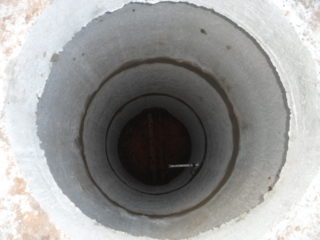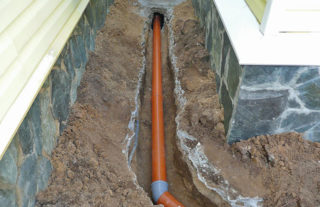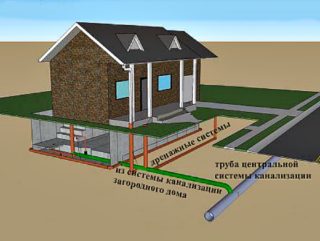When building a personal estate, it is important to create a high-quality sewer system. If the private sector is located in the city, it is worthwhile to connect to the central sewage system if possible.
Advantages of joining a centralized sewage system
Connection to the central sewer line allows:
- Save on material costs. You do not have to purchase equipment for the arrangement of a septic tank and its maintenance. Costs will be minimal.
- Get rid of worries about the cleanliness of drains. This function is assumed by service organizations.
- Use the sewer for a long time, connecting once.
All that is required for the normal functioning of the system is making a monthly payment.
Collection of necessary documents and permits
After planning the connection, contact the survey organization to develop a plan diagram. It is created on the technical plan of the building and the land plot. It is possible to reduce the cost of surveying if you connect houses to a centralized sewer network together with your neighbors.
From additional documents you will need:
- Technical conditions for connecting highways. Created by an organization engaged in the maintenance of sewage systems.
- The project of connecting the drain to the city sewer. It is composed by a design engineer on the basis of a plan and technical specifications.
- Resolution of design documents in the water utility and architecture department.
Further, the owner of the house turns with a package of documents to a company serving the city sewer, most often it is a water utility.
It is necessary to additionally coordinate the project with supervisory organizations, the highways of which may be on the planned sewage route. They include car inspection (when laying through the road), companies that oversee the operation of heat and electricity networks. In addition, it may require the consent of residents of neighboring houses to carry out construction and installation works near their household territories.
Preparatory work
Preparation is carried out in the following sequence:
- A well is installed for revision. Carrying out sewer networks in a private house with a connection to the city highway is possible only if it is available for access during emergency or scheduled cleaning.
- A trench is dug up and a place is prepared where the drain pipe will join the well.
- Already existing house sewer systems are connected to the common output.
The depth of the trench should be 5 cm below the planned deepening of highways. The slope of the pipeline should be an average of 2 cm per meter. With a slight slope, household waste flows slowly, which leads to clogging. If the slope is made too steep, the liquid will go away very quickly, not having time to carry the dirt along. This is also one of the common causes of blockages.
The outer pipe should be larger than the inner riser. Its diameter is from 150 mm to 250 mm. In the case of a public tie-in into the central sewage system, pipes with a diameter of 250 mm are used, elements with a smaller cross section are used to install branches to the yard areas. An additional inspection well is installed on the connection section of each house.
When determining the width of the ditch, they are guided by the following criterion: for a trunk with a cross section of 110 mm, the pit should not be narrower than 60 cm. For a different cross section, the trench width is calculated proportionally.
After completing all the preparatory work, you can contact the city service, which is engaged in connecting a private house to the city sewer.
Connection Methods
 Depending on the type of centralized network, they are connected to it in a separate or mixed way. The first is used if there is a need for a separate connection of domestic and storm sewers. In the second embodiment, it is not necessary to insert two separate highways.
Depending on the type of centralized network, they are connected to it in a separate or mixed way. The first is used if there is a need for a separate connection of domestic and storm sewers. In the second embodiment, it is not necessary to insert two separate highways.
Permission to lay sewer pipes to the city system is issued only when an inspection or overflow well is installed nearby. It is necessary to connect the pipeline from the building to it. Take into account that the pipe section extending from the private house should enter the well at an angle above the drain level.
Laying the highway is carried out to the required depth. Depth is determined depending on the freezing point of the soil: from 1.25 in the south to 3.5 m in the north. The average value is 2 m.
Lay the pipeline as follows:
- The bottom of the dug ditch is leveled and carefully tamped.
- A sand and gravel pillow is poured with a layer of about 15 cm. Compaction along the entire length of the trench is not required. Only near the entrance of the highway and at a distance of two meters from the well, it is necessary to seal the layer.
- Pipes are laid in a trench from the house under a slope with a bell down. The joints of the pipe elements are cleaned of dirt.
- The smooth edge of the pipe section and the bell ring are lubricated with silicone.
- Measure the length at which you want to insert the pipe section into the bell, put a mark.
- The pipe is fully inserted into the bell.
A similar method is used to lay the entire pipeline. After assembly, the angle of inclination is checked without fail, only after that you can fill up the trench. First, a layer of sand and gravel is filled up. The pillow should be 5–10 cm above the pipeline. Then, the gravel-sand layer is abundantly watered with water for good shrinkage. The settled material will protect the pipes from the pressure of the soil and stones and will not allow them to damage the pipeline. This will increase the life of the sewer line. After the sand layer, the rest of the ditch is covered with soil.
Final stage
The last stage is that the local highway is connected to the central network exclusively with the personal presence of a specialist in water services. He will further confirm that all work has been carried out in accordance with sanitary and construction standards.
The contract for the sewage disposal service is signed by the representative of the service organization and the owner of the house. This document reports the amount of domestic wastewater and payment for the provision of the service.
The cost of connecting to a central sewer
How much it will cost to install such a highway depends on many factors:
- region of residence;
- distance from the building to the connection point;
- soil type, depth of freezing and landscape features;
- subsoil water level;
- connection method;
- type of pipe.
The average cost of connecting a private house, which is located less than 50 m from the central sewage system, is 50,000 rubles. The calculation is carried out along with the preparation of documents and materials. The price of the tie-in, if the estate is more than 50 m away, starts at 70,000 rubles.
The selection of the method of waste disposal should be puzzled at the stage of construction of the building. During this period, all connections of devices, pipes, wells and additional equipment can be performed at the lowest cost, without fear of spoiling the landscape of the site and the appearance of the house.





